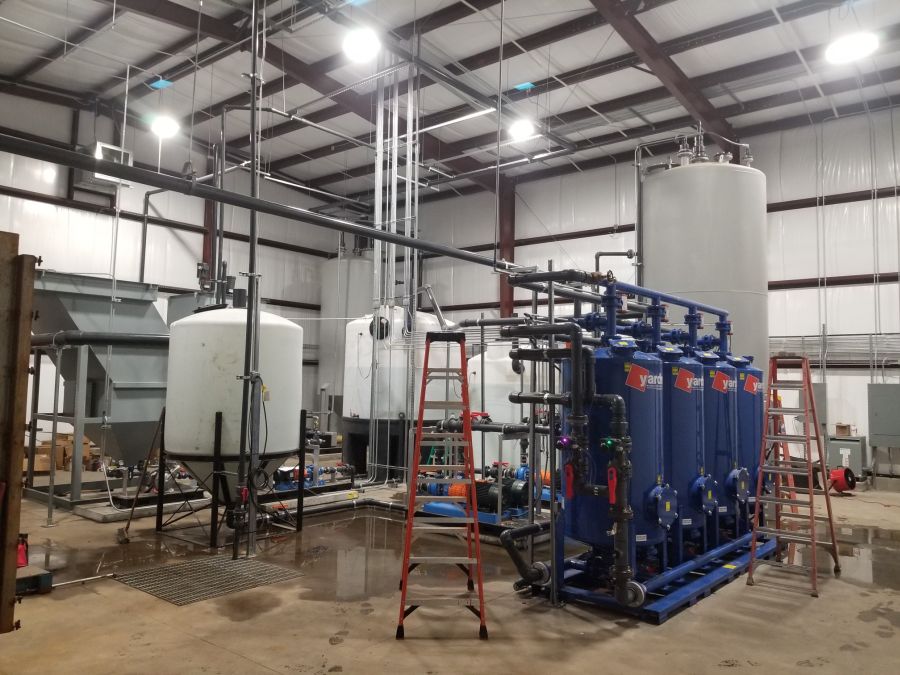Rail Yard Iron and Suspended Solids Treatment System Upgrade and Expansion
MAE2 was selected to provide a system to remove iron and suspended solids and to fully integrate into the operation of an existing system and controls.
While many companies have the ability to build a new system based upon a written specification, expanding an existing system and seamlessly integrating the new components and controls requires extensive industry knowledge and experience. MAE2 was selected to provide a system to remove iron suspended solids and to fully integrate into the operation of the existing system and controls.
The fouling and constant maintenance caused by the iron and suspended solids was preventing the existing water treatment system from effectively reaching the treatment goals required. MAE2’s 23 years of groundwater system design experience, our flexible manufacturing capacity and our UL control panel shop made us the perfect partner to help create a successful solution for a challenging site.

MAE2 worked with the consulting engineer to understand the existing system operation and plan the best way to augment the system and improve the treatment results. The existing system included electric and pneumatic submersible pumps that pumped fuel contaminated groundwater to an air stripper for treatment.

MAE2 worked to design and fabricate custom tanks and to design and program a custom PLC control panel to work with the existing treatment system. In the new expanded system, the extracted groundwater is pumped into a new, custom fabricated, 3000-gallon aeration tank. A chemical metering pump is used to add chemicals into the aeration tank to help precipitate dissolved iron.
Two 5 HP Rotary Claw Compressors skid mounted in parallel provide aeration in the tank at 82 CFM and 22 PSI. Fuel vapors created in the aeration tank are removed by a 3 HP regenerative vacuum blower operating at 55 CFM and 58” WC vacuum. Any residual moisture is captured in an 80-gallon Vapor Liquid Separator that includes a High-Level alarm switch and manual drain.

The vapor steam passes through the blower and then a ½ HP heat exchanger to reduce the temperature so that the 200 LB steel vapor carbon vessel can effectively remove any fuel vapors before discharging to the atmosphere. The Aeration tank is equipped with a user programmable level transmitter that controls the on/off operation of a 200 GPM, 5 HP Centrifugal Transfer Pump. The water is pumped to a custom, three stage clarifier tank.
The tank includes a polymer metering system followed by a flash chamber and electronic mixer, a flocculent chamber and electronic mixer and finally an inclined plate clarifier with hopper bottom. This removes most of the larger suspended solids and precipitated iron. The water gravity feed into a custom, 1000 gallon filtration feed tank. In order to remove any fine suspended solids, the water is pumped through a fully automated, four vessel, sand filter system.
The sand filter includes a 3000 gallon, backwash water tank and a 3000 gallon, backwash solids tank. The system PLC control panel uses pressure transmitters and automated ball valves to backwash the sand filters and pumps the captured solids to the holding tank without stopping treatment flow. A 63 GPM sludge pump controlled by a user programmable level transmitter pumps the collected solids to a custom, 3000 Gallon Settling Tank. The tank has a sludge/solids settling basin in the bottom and a custom designed liquid decanting valve system to drain liquids. The treated, solids-free water, effluent from the sand filtration system is pumped to the existing air stripper for final treatment and removal of any remaining fuel.
This Remediation System uses the following components and subsystems
Regenerative Vacuum Pump
Sand Filter
Rotary Claw Compressor
Incline Plate Clarifiers
Chemical Pre Treatment Systems
Vapor Phase Carbon

